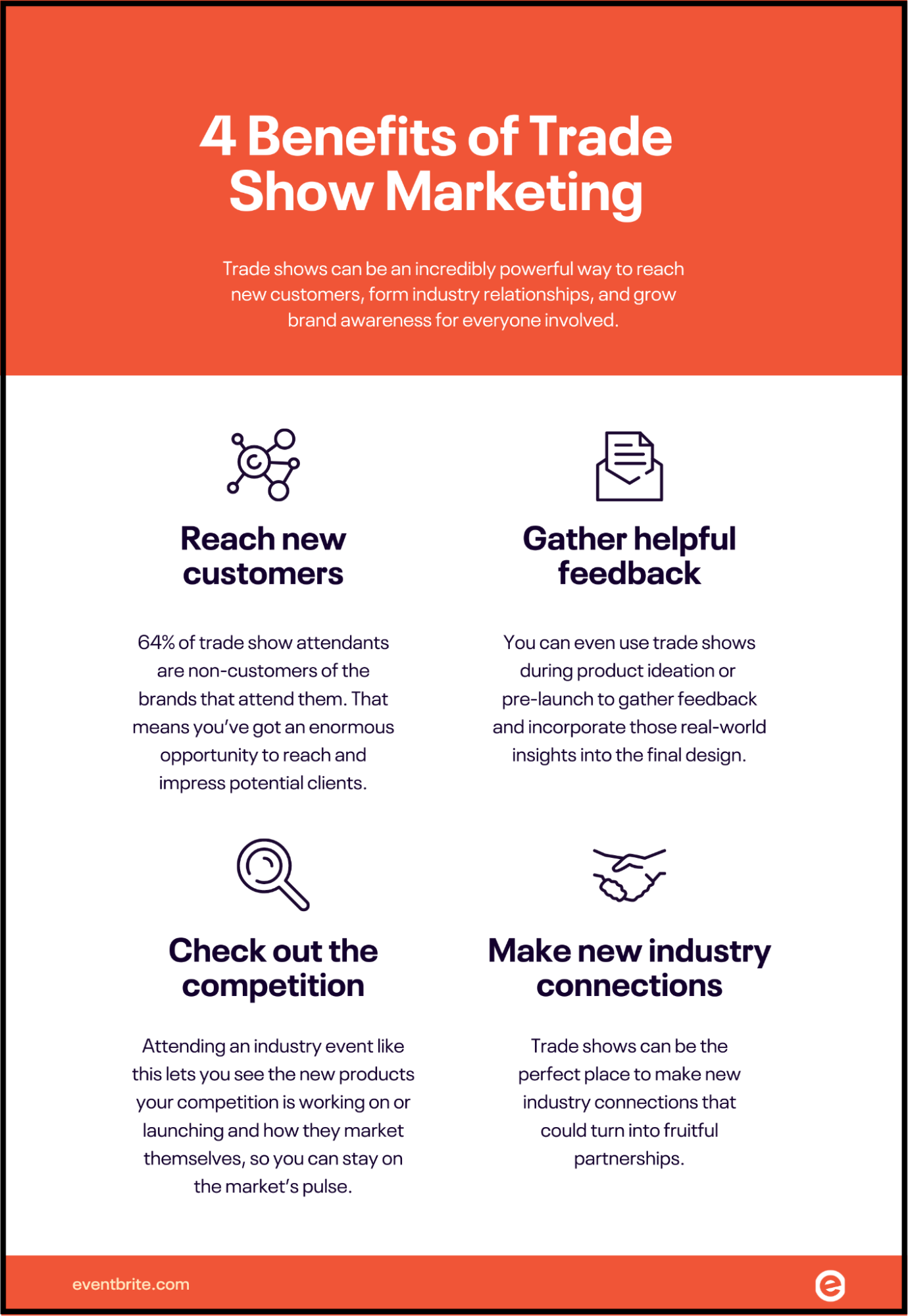Trade shows can be incredibly powerful in boosting brand awareness and enhancing brand associations. Not to mention, they’re a great way to make new industry connections and potentially drive leads and conversions.
Are you considering giving trade show organizing a shot?
Then putting the trade show together is only half the battle — you’ve got to get exhibitors and attendees to show up, and this guide can help you do just that.
But trade shows are just as intensive for exhibitors — hosting a booth at a trade show is no small undertaking.
Getting the event to run smoothly and showing a good return on investment (ROI) can prove challenging. So, at Eventbrite, we’ve drawn from our experience from our many years of helping event creators to provide you with the ultimate guide to trade show marketing.
We’ll kick off by helping organizers and event creators achieve their trade show marketing goals by providing actionable advice and practical tools for maximizing exhibitor and attendee turnout. Then, we’ll dive into helping businesses and entrepreneurs maximize ROI and make a huge splash with their next trade show attendance.
You’ll learn:
- What trade show marketing is and why it’s important for event creators
- Our expert tips for marketing a trade show
- Practical tools for organizing a trade show
- Why trade show booths really are a good way of marketing
- How to make the most out of your upcoming trade show attendance
Why is trade show marketing important for event creators?
A trade show is an event where businesses in a given industry or vertical get together to show off their latest and greatest products, services, or features. As the event promoter, you’re in charge of organizing the trade show itself, and then collaborating with the various companies and entrepreneurs who wish to host a booth.
You can host trade shows for industries that produce physical products, such as the arts, automotive, engineering, and consumer tech sectors. But you can also host them for “non-product” industries like the event industries or for sectors like real estate. It’s a very diverse type of event marketing.
For example, event organizer Afrika Trade Show holds a yearly trade show that allows entrepreneurs from Africa or with African origins to meet, promote their brand, and showcase their “Africa-made” products and services.
A trade show like this is a great way to bring entrepreneurs and businesses together who have something in common, and help them forge new business relationships and generate leads — in 2022, 70% of companies that attended trade shows generated more leads and/or created more brand awareness.
Thus, trade shows are a win-win situation. Those who host a booth have an opportunity to expand their reach, meet new customers, and generate leads, while the event organizers and creators can use the trade show to maximize their brand awareness and generate good ROI.
Of course, all of this hinges on the idea that you’re able to attract a significant number of people to the event in the first place.
Let’s explore how to best achieve good turn out at a trade show.

Six expert tips for marketing a trade show
Organizing a trade show is an interesting challenge. Most other events only have one type of attendee, but with trade shows, you have the added challenge of marketing to two separate audiences.
- Exhibitors, who will be your main attraction for…
- Tradeshow attendees
Of course, once you’ve secured enough exhibitors, they’ll also market the event to their target audience, increasing reach and attendance. But you want to make sure you play your part in attracting plenty of the right people so that your exhibitors achieve their goals and return next time you repeat the event. And let’s not forget that although you may love what you’re doing, you’re likely going to have some ROI goals of your own to hit!
The marketing tips that follow will help you both with marketing to exhibitors and to attendees.
1. Create a simple website
Whatever your marketing efforts are, you need to have a base camp where potential exhibitors and attendees can find all the necessary information about your trade show. This is where you’ll have your trade show information, including any relevant information for exhibitors, such as exhibitor packages, levels of sponsorship, etc.
You can invest a ton of money into your website, or you can create a simple, free website with a smooth ticketing system by creating a professional event page on Eventbrite. Best case scenario? You have both sending traffic to one another!
Eventbrite’s built-in tools make it easy to create a professional event listing that’s compelling and memorable, complete with beautiful design features, built-in payment processing, and seamless integrations.
2. Create an enticing exhibitor package
A detailed exhibitor package, outlining all necessary information, ensures smooth execution and helps attract and retain potential exhibitors. It should comprehensively detail the event while highlighting the benefits that exhibitors stand to gain.
Here are the key components that should be included in the exhibitor package:
- Event details: Clearly communicate the purpose, date, and time of the event.
- Target audience: Describe who the event is targeting. This will help potential exhibitors assess if these are the demographics they want to reach.
- Services: Outline the services that will be provided to the exhibitors. This could include things like booth setup assistance, promotional services, and more.
- Location information: Include information about the event venue, including its location, layout, and any relevant amenities it might have.
- Contact details: Provide contact details for the event organizers. This will make it easier for potential exhibitors to get in touch if they have any queries or concerns.
- Special offers: Highlight any special offers or discounts available to exhibitors. This could be early-bird pricing, discounts for booking larger spaces, or other incentives designed to encourage sign-ups.
You can share your exhibitor package through your chosen promotional channels to ensure it reaches as many as possible, as well as placing it on your event website.
Pro Tip: Create a dedicated event on Eventbrite to invite exhibitors to get to know your exhibitor package and event plan, and purchase their package by offering different tickets for each sponsorship level — just like ASPPR have done for their annual convention:

3. Show up where your audience is
Now you have your event website, knowing where your audience is and where you can reach them is the next step in a successful trade show marketing campaign.
Think about it: if you’re promoting the event on TikTok, but your audience spends the majority of their social media time on Instagram, you’re simply not reaching the people you need to.
So, a bit of audience research, both for potential exhibitors and attendees, is in order before you start promoting the event.
Pro tips for finding out where your audience hangs out:
- Take a look at previous trade shows in the same industry (ideally ones that were highly successful, and that you aspire to). What kind of marketing activities did they engage in? What channels did they use? Which businesses set up booths at the event? What compelled people to attend?
- Once you’ve secured some exhibitors, turn your attention to their marketing efforts. Where are they speaking to their buyers? Remember, their customers are your customers, so if you can find out where the majority of company-customer interactions are happening, you know where to play.
Once you’ve established the right channels for trade show promotion, you’ll have to create a plan for:
- Social media promotion — where you plan your social media content, including pre-, during- and post-event posts.
- E-mail marketing — where you reach out to existing contacts and any new contacts you generate along the way, marketing your event and its benefits to that audience.
- Press releases — where you’ll publicize your trade show through press releases to relevant media outlets for wider coverage.
This may sound like a lot, but spending a few hours creating a marketing calendar with what you’ll post, where, and when you’ll post it, will ensure you have a coherent and effective strategy that’s easy to carry out when you’re in the logistics haze of event creation.
Pro tip: Use the Eventbrite Organizer to reach more people through its integrated email and social media marketing tools.
Check out Eventbrite’s marketing integrations.

4. Leverage your trade show exhibitors’ reach
One of the great things about putting on a trade show is that your incentives are aligned with those who are paying to host a booth: both of you want more attendees on the day.
Any company or entrepreneur who signs up to run a booth at your event should be promoting like crazy on their channels, and you want to help them do so effectively.
Encourage any existing exhibitors and stakeholders to share information about your trade show with their networks, leveraging their relationships and credibility to generate interest and attract new exhibitors. This word-of-mouth approach can be highly effective in reaching a wider audience and building trust within the industry community.
Pro tip: A great way to encourage trade show partners to promote the event is to provide them with marketing collateral such as a logo, imagery, and pre-written copy that they can use to quickly put together social media posts or email campaigns.

5. Provide shareable links in all your digital marketing
At each interaction you have with a potential attendee (for instance, an ad or organic post on your Twitter channel), make sure to include a shareable link to your event page or website.
This way, those who are excited to attend can share their joy with friends, family, and colleagues, maximizing your reach to audiences you might not have otherwise gotten in front of.
Pro tip: Make sharing as simple as a single action with click-to-share links at the bottom of your marketing emails, and offer incentives to attendees whose sharing results in a new ticket purchase.
6. Think beyond ads and social media
We’ve got one last tip for maximizing attendance at your trade show:
Think broad.
Many event organizers stick to the obvious when it comes to trade show promotion:
- Social media posts
- Email marketing
- Digital banner and social media ads
These are great forms of marketing and a powerful way to reach more potential exhibitors and attendees, but consider ways in which you might be able to leverage existing audiences to maximize reach.
For example, are there any relevant and popular podcasts in your industry that you could be a guest on? That would be a great way to tap into a captive audience and promote your upcoming trade show while simultaneously building trust by sharing valuable advice on the episode.
Or could you partner with a local brand (that will be attending your trade show) to run a promotion? For instance, a giveaway that’s drawn on the day of the event, for which the winner must be present to receive, is a powerful way to turn “Yeah, I might go” to “I will 100% be there.”
There are countless creative ways to create buzz and reach a wide audience to maximize attendance. Of course, with all of those new people attending, you’re going to need a way to manage aspects like ticketing and registration.
Let’s turn our attention to some effective expert tools to help trade show organizers run a smooth event.

Effective tools for organizing a trade show
If you’re looking into organizing a trade show of your own, here are 10 powerful tools that Eventbrite’s event marketing platform offers to help you make it a magical, impactful event (and make it a little less stressful for you!):
- Online Ticketing: Create and manage event tickets, allowing trade show attendees to register and purchase tickets in advance.
- Mobile Ticketing: Utilize the Eventbrite Organizer App to easily scan and validate tickets at the entrance, improving the check-in process.
- Event Registration: Customize registration forms to collect relevant attendee information, such as contact details, company names, and job titles.
- Event Promotion: Leverage Eventbrite’s promotional tools to market your trade show, including email campaigns, social media integration, and tracking links.
- Ticket Types and Pricing: Offer various ticket types (e.g., general admission, VIP, exhibitor) with different pricing options, discounts, or early bird rates.
- Attendee Communication: Communicate important event details and updates to attendees through Eventbrite’s messaging features or automated emails.
- Analytics and Reporting: Access real-time data and analytics on ticket sales, attendee demographics, and check-in statistics to gain insights and make informed decisions.
- Check-In and Badge Printing: Use Eventbrite’s on-site check-in tools and badge printing functionality to streamline attendee check-in and provide professional event badges.
- Integrations: Connect Eventbrite with other event management tools, such as CRM systems or marketing tools, to synchronize data and streamline processes.
- Post-Event Surveys: Gather feedback from attendees through post-event surveys to evaluate the success of your trade show and make improvements for future events.
Organizing a trade show can be a great way to capitalize on the benefits discussed above while further solidifying your brand as an industry leader and maximizing branding opportunities.
So far, we’ve been discussing the benefits involved in hosting a trade show, and exploring expert tips and pro tools to help trade show organizers maximize attendance. Now, we’ll turn our attention to how companies and entrepreneurs can make the most of trade shows as a marketing channel.
Why trade show booths really are a good way of marketing
Like all forms of marketing, there are many factors to consider when determining whether something is a “good” way of marketing.
Whether or not a trade show is valuable depends on the following:
- Your business / industry / customers — is your target audience likely to attend one in the first place?
- Your goals — is your goal to drive brand awareness or promote a product?
- How you make use of the trade show — keep reading for tips on this!
To help you decide whether trade show marketing is a good fit for you, let’s talk about four ways trade show marketing can benefit your brand.

1. Reach new customers
A substantial 64% of individuals attending trade shows aren’t existing customers of the brands present at these events. This demographic represents a significant chance for you to capture the attention of and make an impression on potential clients.
Imagine you’re a venue owner promoting your venue for events. Most attendees in the events trade need a venue, but they’re likely not existing customers. That’s a vast sea of prospects ready to be converted into loyal, paying customers.
2. Gather helpful feedback
Exhibitions provide a great opportunity to get instant feedback on a new product launch. Plus, you can gather reviews during the product development or pre-launch stages. The practical insights you gain can then be incorporated into the final product design.
3. Check out the competition
Attending industry-specific gatherings allows you to see firsthand the latest product developments and marketing strategies used by your competitors. It helps you stay in tune with the ever-changing market dynamics and stay ahead of the game!
You also get to see how potential customers engage with competitor brands and how consumers talk about competitor products or services.
4. Make new industry connections
Trade shows offer a fantastic chance to connect with industry professionals, fostering relationships that can blossom into fruitful partnerships. These events provide a platform to exchange ideas, explore synergies, and discover innovative solutions together.
By leveraging the power of networking at trade shows, businesses can expand their reach, tap into new markets, and unlock exciting growth opportunities
You might meet someone who could become a team member, a future business partner, or someone with whom your brand could collaborate on a product line or future event.
How to make the most of attending a trade show
Remember, it’s not just about showing up at the event. Ensure that attending an industry trade show means something for your business and marketing goals. Here’s how.

1. Get super clear on your objectives
Before you start looking at potential trade shows to attend, it’s important to get clear on your reasons for showing up.
Is your goal simply to establish a presence in the industry? Is it to get early sign-ups for an upcoming product release? To gather feedback on a new product release?
You might have multiple goals for a single trade show, and that’s completely fine (though you should aim to land on one to three mission-critical objectives to focus your efforts on).
If you work as part of a larger team, sitting down with them to run a goal-setting session can be immensely helpful. Not only will it focus your efforts at the event itself, but it will also provide you with a framework for your marketing and for measuring the impact and success of your attendance.
2. Make sure the timing is right
Okay, so you know what you want from a trade show event. But is it the right time for you to attend? Consider these questions to guide you in your decision:
- Do you have the ability to pull together the relevant collateral?
- Do you have a new launch coming up?
- Have you rebranded recently?
These signals can tell you if a trade show is a good idea right now, and help you make the most of attending the trade shows you choose to go to.
3. Create an action plan for the event
You want to maximize your ROI and hit your trade show marketing goals, and creating an action plan will put you on the right path.
Divide marketing and action planning into three stages.
1. Pre-event
Think here about how you’ll market the trade show and promote your attendance to attract customers to your booth.
For example, how and when will you promote the event on social media? Will you run ads, or stick to organic posts?
2. Day of
Think carefully (before the day) about how to use your time wisely on the day:
- What are you going to focus on during the event?
- Who is going to be where and doing what?
- How might this change throughout the event?
Intimately link your action plan to the goals you established in the first step.
Pro Tip: If you’re thinking of using your trade show booth to host mini-events such as guest speakers or product workshops, you can use Eventbrite for ticketing and registration, so nobody misses out due to capacity limitations or clashing events.

4. Select hyper-relevant trade shows to maximize your budget
You don’t need to attend every trade show your brand or company qualifies for.
Here’s the thing — trade shows are not cheap.
A small 10×10 booth costs an average of $14,000, and that only accounts for around 35% of the total cost of attending. When you’re looking at putting down $40k+ for a single trade show, you need to select carefully.
To maximize the impact of your trade show budget, select only the trade shows that are incredibly relevant to your target audience and to your event-specific goals.
For example, attending a general consumer tech trade show if you’re promoting a new set of headphones likely won’t yield a strong ROI because only a small percentage of the people attending are within the target demographic.
However, a trade show for audio industry professionals is more likely to be relevant, and will undoubtedly provide a more substantial ROI.
3. Post event
What does your post-event marketing strategy look like?
Consider how you’ll capitalize on the leads you generate or the relationships you form at the trade show.
For instance, will you reach out to each person individually with a personalized conversation, like this one?

Or use an automated email marketing campaign?
Eventbrite provides a comprehensive platform to manage your event, from running an engaging automated email campaign to handling registrations. Additionally, you can leverage Eventbrite’s built-in analytics to gain insights into your event’s performance.
Need help with automating your email marketing?
Try Eventbrite’s email marketing solutions.

5. Prepare your booth and marketing collateral
Now that you’ve decided to attend an upcoming trade show, it’s time to start pulling together your marketing materials.
First, you’ve got the trade show booth itself, which needs to be adequately branded but also be eye-catching and stand out amongst a sea of other booths.
A few creative ideas include:
- Backlit canvases
- Large-scale installations & artworks
- Fog machines
Expert insights: 35 Creative Trade Show Booth Design Ideas to attract a huge audience.
But you need to think beyond the booth and consider what other forms of marketing collateral you’ll need to prepare to maximize reach after the event and capitalize on brand recognition opportunities.
For example you should include flyers, product catalogs, and valuable swag.
6. Write a post-event report
Creating a post-event report after a trade show is super important for multiple purposes. It gives a comprehensive overview of the event, capturing insights, observations, and experiences in a structured way for future analysis.
This report helps you make strategic decisions, assess the trade show’s effectiveness in achieving your objectives, and guides your future participation. Plus, it’s a great platform to document potential leads, partnerships, and opportunities you identified during the event.
Some tips for an effective report include setting clear objectives, organizing information into sections like key takeaways, leads generated, competitive analysis, and action points. And don’t forget, incorporating quantitative data adds even more value to the report for evaluation and comparison. You can do this by using data analytics included in Eventbrite’s dedicated marketing tools.

Trade show marketing made easy
Organizing a trade show can bring significant benefits for event creators. It has the potential to boost brand awareness, enhance brand associations, and establish valuable industry connections.
For exhibitors, trade show marketing can increase the impact of attending a trade show, generate more leads and drive conversions and maximizing ROI.
To ensure a successful trade show, it’s not enough to simply attend — you need to create and engaging experience. Eventbrite has all the tools to help you do this. Whether it’s managing sign-ups for the event, selling tickets to in-show events, or planning a post-trade show email campaign, Eventbrite’s got your back.
Check out our event management platform here!
Discover how we can help you make the most of your upcoming trade show.






